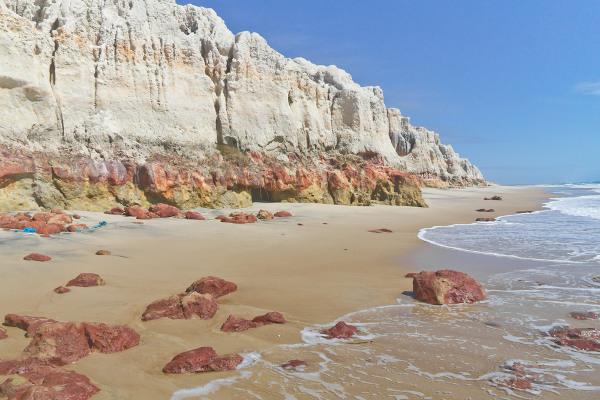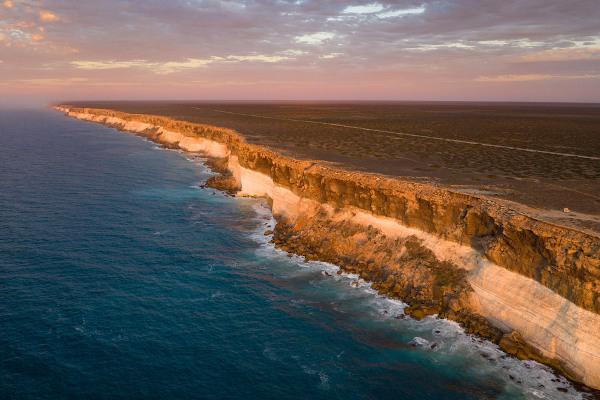Cliffs are forms of the relief coast derived from the marine abrasion process, which is erosion caused by the continuous action of sea water on a rocky surface. are characterized by high and very steep escarpments, without vegetation in its vertical extension.
Escarpments are landforms composed of a steep wall commonly located on the border between plateaus and lowered areas, resulting from erosion or tectonic movements.
Cliffs are classified as active/living, those where the erosion is ongoing, or inactive/dead, which are no longer affected by seawater. They constitute beautiful landscapes around the world and are also observed in the Brazil, mainly on the beaches of the northeast coast.
Read too: Marine currents — large bodies of water moving through the oceans
Summary about cliffs
Cliff is a feature of coastal relief formed by the process of marine abrasion.
They are steep walls that can be tens or hundreds of meters high.
The cliffs are devoid of vegetation.
The coloring that the cliffs exhibit depends on the rock type in which they formed.
They are divided into active (living), in which the processes of marine erosion are in progress, and inactive (dead), no longer susceptible to erosion by the action of water. Water from the sea.
In Brazil, they are found along the entire coast, but are concentrated in the states of North East.
What are cliffs?
Cliff is the name given to a geomorphological feature found in the coastal zone, that is, on the coast. They are present in several countries and constitute an abrupt escarpment, with a marked degree of declivity, derived from the action of erosive agents, especially from sea water.
Do not stop now... There's more after the ad ;)
Causes of cliffs
The cliffs are landforms caused by the constant action of the sea water and also the rains over the rocks that form the substrate of land located on the coast, very close to the coast, many of them in almost direct contact with the sea due to the existence of narrow beaches. The official definition of Brazilian Institute of Geography and Statistics (IBGE) also includes the river erosionas one of the causes of the cliffs|1|.
Formation of the cliffs
the cliffs are formed from the marine abrasion process, which is the name corresponding to the erosion caused by the impact of sea water on nearby rocky surfaces, giving rise to natural landscapes characteristics. Regarding the formed walls, Sculpture is directly associated with the dynamics of oceans and the movement of waves, which make the waters come into contact with the emerged portions of land and lead to their wear.
In the course of time, the water manages to excavate the base of these terrains and causes the collapse of upper blocks. The sediments and other types of fragments derived from this process are deposited in the lower portion of the walls and form the so-called terraces or abrasion platforms. As the sea advances and affects the cliffs, causing the erosion process to continue, the abrasion platforms increase.
It is also noted that the sediments resulting from marine abrasion on the walls can be transported by water and deposited in another area, also contributing to the formation of a coastal relief.
Video lesson on relief shaping agents
Characteristics of the cliffs
The cliffs are characterized by a extensive rocky wall that is distributed along the coastline, very close or in direct contact with the sea. These walls are quite steep and have variable height. In Brazil, for example, there are cliffs that project from 20 to 30 meters above sea level.
In the rest of the world, walls of hundreds and even thousands of meters are found that extend horizontally for tens of kilometers. It is also important to note that the cliffs are devoid of vegetation throughout their vertical extension.
The coloring that the cliffs exhibit depends on the type of rock that compose them.. The cliffs carved in volcanic rocks, very common in the north of Europe, for example, have a dark color, while those formed by carbonate sedimentary substrate are generally light. When formed in sandstones, they have a color that varies between reddish and beige tones. In those walls formed in sedimentary deposits, it is clearly observed the disposition of the several layers that each have a different color or tonality.
They they can to be classified into active (alive) cliffs or inactive (dead). Active cliffs are those on which marine abrasion acts continuously. Inactive cliffs, on the other hand, are those that are no longer subject to erosion processes resulting from seawater. They have gentler slopes and are a little farther from the shoreline.
Know more: Plate tectonics — the semi-rigid blocks of rock that form the Earth's crust
Cliffs in Brazil

There are several cliffs along the Brazilian coast. The highest concentration of this landform occurs in the states of the North East, as we will see in the list below. It is important to point out that we have only listed some of the cliffs in these areas, many of which are tourist attractions and areas of study.
Some of Brazilian states that have cliffs are:
maranhão, with the Itapari and Baronesa cliffs;
large northern river, on the beaches of Minas and Pipa, in Tibau do Sul;
alagoas, in Barra de Santo Antônio;
Paraíba, in Ponta do Seixas, in João Pessoa, and Carapibus, in Conde;
Bahia, at Farol beach, in Prado, Arraial d’Ajuda and Praia Dourada, in Mucuri;
Ceará, which is home to a large number of cliffs. The formations of Morro Branco, located in the city of Beberibe, are well known.
In the region Southeast, the cliffs are observed in beaches of the Holy Spirit and Rio de Janeiro. Considering the locations mentioned so far, it is noted that these formations occur especially in sedimentary rocks that make up the Barreiras Group.
There are also cliffs in the south of Brazil, among them those originating from volcanic rocks in Torres, in the Rio Grande do Sul.
Check out our podcast: Tsunamis in Brazil: possibility or legend?
cliffs in the world
the cliffs are found on the coasts of the five continents, formed in the most diverse types of rock. The US state of hawaii has some of the most beautiful landscapes with cliffs in the world, among which are the cliffs of Kalaupapa, which reach a vertical extension of one thousand meters.
European countries They also have a large number of walls carved in limestone and volcanic rocks, mainly such as:
Norway;
Ireland;
Iceland;
United Kingdom;
Greece;
France;
Spain;
Portugal.
Of particular note are the cliffs of Étretat, in the French region of Normandy; the formation of Moher in Ireland; Dover, formed along the English Channel; and Preikestolen, located on a fjord in Norway.

At the northwest africa it is possible to find cliffs on the island of Tenerife, which makes up the Canary Islands. Some impressive landscapes with immense vertical walls are also seen in countries and islands of the South and Southeast Asia, as in Taiwan, and in australian coast.

Importance of cliffs
the cliffs are important for the study of ocean dynamics and the way in which tidal behavior interferes with coastal relief. In addition, the analysis of its evolution provides significant evidence of the advance of sea waters over the continent over geological time.
The importance of the cliffs also includes environmental preservation, because they are formations with a high degree of fragility and that demand specific care in their process of use and occupation when allowed, in addition to some of them harboring animal and plant species, especially the cliffs inactive.
The economic role of these formations is also highlighted., since they contribute to the tourism of the areas where they are located, in view of the beauty of their features. They can also be a source of raw material for activities such as civil construction and handicrafts. This is the case of the cliffs of the Brazilian Northeast, which present a diversity of deposits sediments and provide the formation of colored sand, used in the composition of arts such as cyclogravure.
Grades
|1| IBGE Geological Glossary. Rio de Janeiro: IBGE, 1999. Available here. Accessed on 26 Nov. 2021.



